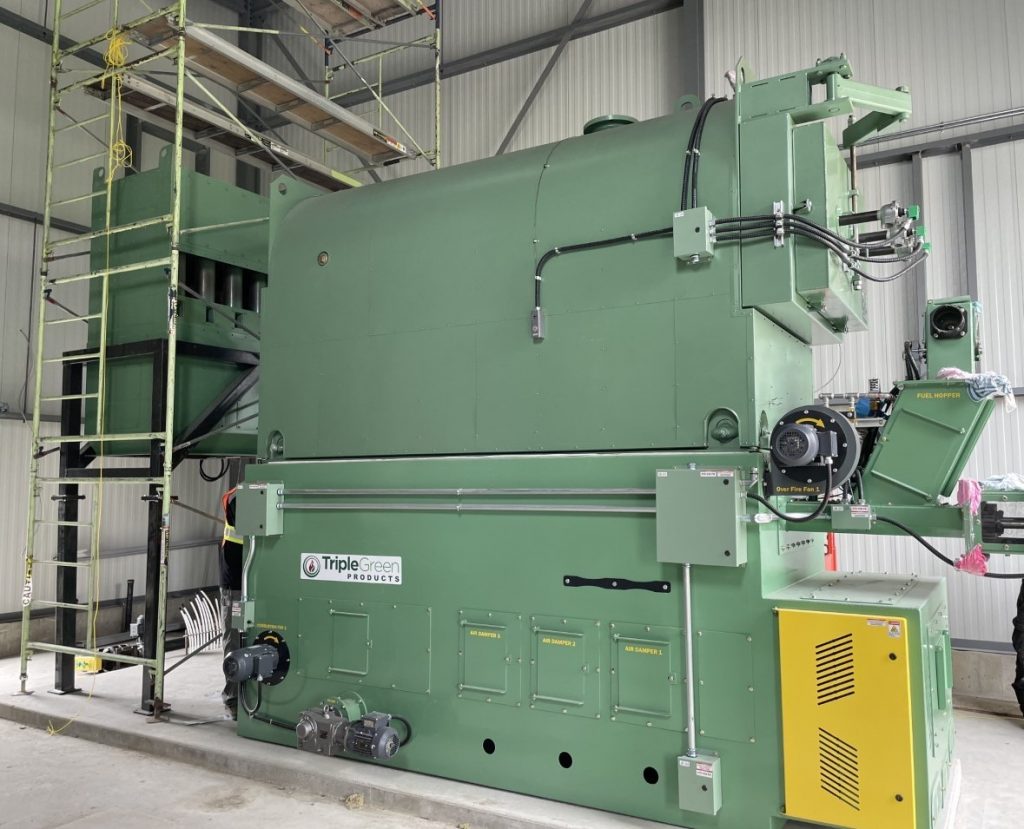
A better way to saving money and saving the planet
August 31, 2021
By Karen Brandt, Contributor
Brought to you by Triple Green Products
 A recent project install at hospital, Triple Green Product’s technology can save industrial users as much 50-80 per cent over fossil fuels including natural gas. Photo: Triple Green Products
A recent project install at hospital, Triple Green Product’s technology can save industrial users as much 50-80 per cent over fossil fuels including natural gas. Photo: Triple Green Products From agriculture to manufacturing to delivery of health services, the cost of using traditional energy sources and landfills for waste, and the taxes imposed for using them, are driving operational costs for business sky high. Many businesses think that they have no choice but to absorb these costs, but the fact is there is a better way and spoiler alert…we don’t have to look very far to find it.
From its rich forests to its expansive farmland, Canada is rich in responsible, renewable clean energy, and the technology and expertise to turn biomass into heat and energy can be found at Triple Green Products (TGP) located in the small farming community of Morris, Man. Twenty years young, this company has gained a national and international reputation as a leading innovator in the green energy sector. From apartment complexes to warehouses to industrial food processors to greenhouses and hospitals, TGP is saving customers money while addressing the environmental concerns of today and into the future.
“Our goal is to save our customers money and we can do that with our technology and equipment. Our systems can use just about any form of biomass from wood chips and wood pellets to oat hulls and straw including waste from construction sites – our equipment can turn basically anything that burns into energy and heat,” says Lyall Wiebe, the company’s CEO.
What makes TGP stand out is that they build systems to an industrial standard and their technology takes it to a new level which allows their heating systems go to a pilot light status bypassing the need for large buffer tanks when the energy is not required. This creates a cost savings of 50-80 per cent over fossil fuels including natural gas. In addition, the company’s BioDryAir system is taking both small and large industrial operators in the farming, forestry and mining sectors off fossil fuels by offering a carbon neutral solution for aggregate and grain drying systems – up to 33,000,000 BTU for a single unit.
TGP may have originally been ahead of its time in Canada; but in the global race to get to carbon zero, TGP and Canada’s biomass sector have lots to offer. Wiebe says while there’s never been a better time to be in the biomass sector, he believes the wood products sector and governments have yet to tap into the full potential of wood waste.
“There are three fundamental challenges to using wood biomass in Canada,” explains Wiebe. “First, it’s a challenge to educate customers that burning forest waste for energy is a good thing, and second, politics – homegrown wood biomass just isn’t sexy compared to the bigger industries like oil and gas; and probably the biggest challenge is producing wood pellets for domestic use.
“Between the export of wood pellets to international customers and the tens of millions of metres of wood waste left in the forest every year after logging, there isn’t much left for domestic customers,” adds Wiebe, who says he has major industrial greenhouses in British Columbia that can’t source wood chips or wood pellets when the fibre they need is lying on the forest floor or burned in slash piles.
It’s a lost opportunity for wood pellets, says Wiebe, whose customers have turned to agricultural crops such as corn, straw and oat hulls, taking advantage of the flexibility of TGP equipment that can burn any form of biomass. Wiebe is hoping that as governments turn their attention to climate change that policy will also evolve to ensure biomass finds its rightful place in the global efforts to reduce greenhouse gas emissions. It’s a message the company recently took to WPAC’s Maritime Bioheat Conference which they sponsored.
The solutions and the opportunities in Canada really are limitless, says Wiebe, pointing to areas like Leamington, Ont., which is home to the largest concentration of food producing greenhouses in North America covering over 1,200 hectares (3,000 acres) that primarily use fossil fuels for their energy.
Countries around the world have embraced biomass and are driving the demand for Canada’s natural resources, including Austria, where 40 per cent of the homes are heated with biomass. Despite these global trends, communities across North America remain dependent on fossil fuels to provide heat. Heating an entire community with a TGP boiler is possible with a single boiler being capable of producing up to 33,500,000 BTUs (9810 kW).
“We have biomass in almost every corner of this country and yet we aren’t using it to its fullest potential,” says Wiebe. “We haven’t even scratched the surface of what’s possible.”
Getting businesses and communities off fossil fuels and saving them money are the key tenets of Triple Green’s business philosophy and the reason for their success. Customers see a return on investment within three to five years of installing Triple Green’s equipment.
It’s a philosophy that is personal for the company and its team of more than 100 Canadians. “We all have families and we all want to this place to be a better place than when we found it,” says Wiebe. “We are immensely proud of what we have accomplished and believe the future is very bright for our company, our industry and Canadians.”
To read more about Triple Green Products visit their website.
Print this page